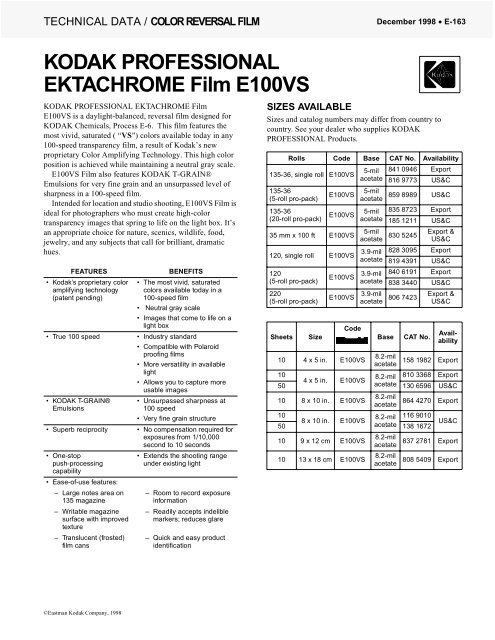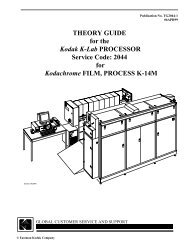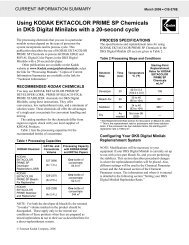KODAK PROFESSIONAL EKTACHROME Film E100VS - 125px
KODAK PROFESSIONAL EKTACHROME Film E100VS - 125px
KODAK PROFESSIONAL EKTACHROME Film E100VS - 125px
You also want an ePaper? Increase the reach of your titles
YUMPU automatically turns print PDFs into web optimized ePapers that Google loves.
TECHNICAL DATA / COLOR REVERSAL FILM<br />
<strong>KODAK</strong> <strong>PROFESSIONAL</strong><br />
<strong>EKTACHROME</strong> <strong>Film</strong> <strong>E100VS</strong><br />
<strong>KODAK</strong> <strong>PROFESSIONAL</strong> <strong>EKTACHROME</strong> <strong>Film</strong><br />
<strong>E100VS</strong> is a daylight-balanced, reversal film designed for<br />
<strong>KODAK</strong> Chemicals, Process E-6. This film features the<br />
most vivid, saturated ( “VS") colors available today in any<br />
100-speed transparency film, a result of Kodak’s new<br />
proprietary Color Amplifying Technology. This high color<br />
position is achieved while maintaining a neutral gray scale.<br />
<strong>E100VS</strong> <strong>Film</strong> also features <strong>KODAK</strong> T-GRAIN®<br />
Emulsions for very fine grain and an unsurpassed level of<br />
sharpness in a 100-speed film.<br />
Intended for location and studio shooting, <strong>E100VS</strong> <strong>Film</strong> is<br />
ideal for photographers who must create high-color<br />
transparency images that spring to life on the light box. It’s<br />
an appropriate choice for nature, scenics, wildlife, food,<br />
jewelry, and any subjects that call for brilliant, dramatic<br />
hues.<br />
FEATURES BENEFITS<br />
• Kodak’s proprietary color<br />
amplifying technology<br />
(patent pending)<br />
• True 100 speed<br />
• <strong>KODAK</strong> T-GRAIN®<br />
Emulsions<br />
©Eastman Kodak Company, 1998<br />
• The most vivid, saturated<br />
colors available today in a<br />
100-speed film<br />
• Neutral gray scale<br />
• Images that come to life on a<br />
light box<br />
• Industry standard<br />
• Compatible with Polaroid<br />
proofing films<br />
• More versatility in available<br />
light<br />
• Allows you to capture more<br />
usable images<br />
• Unsurpassed sharpness at<br />
100 speed<br />
• Very fine grain structure<br />
• Superb reciprocity • No compensation required for<br />
exposures from 1/10,000<br />
second to 10 seconds<br />
• One-stop<br />
push-processing<br />
capability<br />
• Ease-of-use features:<br />
– Large notes area on<br />
135 magazine<br />
– Writable magazine<br />
surface with improved<br />
texture<br />
– Translucent (frosted)<br />
film cans<br />
• Extends the shooting range<br />
under existing light<br />
– Room to record exposure<br />
information<br />
– Readily accepts indelible<br />
markers; reduces glare<br />
– Quick and easy product<br />
identification<br />
December 1998 • E-163<br />
SIZES AVAILABLE<br />
Sizes and catalog numbers may differ from country to<br />
country. See your dealer who supplies <strong>KODAK</strong><br />
<strong>PROFESSIONAL</strong> Products.<br />
Rolls Code Base CAT No. Availability<br />
135-36, single roll <strong>E100VS</strong><br />
135-36<br />
(5-roll pro-pack)<br />
<strong>E100VS</strong><br />
135-36<br />
(20-roll pro-pack) <strong>E100VS</strong><br />
5-mil<br />
acetate<br />
5-mil<br />
acetate<br />
5-mil<br />
acetate<br />
35 mm x 100 ft <strong>E100VS</strong><br />
5-mil<br />
acetate<br />
120, single roll <strong>E100VS</strong> 3.9-mil<br />
acetate<br />
120<br />
(5-roll pro-pack)<br />
220<br />
(5-roll pro-pack)<br />
Sheets Size<br />
<strong>E100VS</strong> 3.9-mil<br />
acetate<br />
<strong>E100VS</strong> 3.9-mil<br />
acetate<br />
Code<br />
841 0946 Export<br />
816 9773 US&C<br />
859 8989 US&C<br />
835 8723 Export<br />
185 1211 US&C<br />
830 5245<br />
Export &<br />
US&C<br />
828 3095 Export<br />
819 4391 US&C<br />
840 6191 Export<br />
838 3440 US&C<br />
806 7423<br />
Export &<br />
US&C<br />
Base CAT No. Availability<br />
10 4 x 5 in. <strong>E100VS</strong><br />
8.2-mil<br />
acetate<br />
158 1982 Export<br />
10<br />
50<br />
4 x 5 in. <strong>E100VS</strong><br />
8.2-mil<br />
acetate<br />
810 3368<br />
130 6596<br />
Export<br />
US&C<br />
10 8 x 10 in. <strong>E100VS</strong><br />
8.2-mil<br />
acetate<br />
864 4270 Export<br />
10<br />
8.2-mil 116 9010<br />
8 x 10 in. <strong>E100VS</strong><br />
US&C<br />
50 acetate 138 1672<br />
10 9 x 12 cm <strong>E100VS</strong><br />
10 13 x 18 cm <strong>E100VS</strong><br />
8.2-mil<br />
acetate<br />
8.2-mil<br />
acetate<br />
837 2781 Export<br />
808 5409 Export
STORAGE AND HANDLING<br />
Load and unload film in subdued light.<br />
Store unexposed film in a refrigerator at 55°F (13°C) or<br />
lower in the original sealed package. To avoid moisture<br />
condensation on film that has been refrigerated, allow the<br />
film to warm up to room temperature before opening the<br />
package. Process film as soon as possible after exposure.<br />
Protect transparencies from strong light, and store them in<br />
a cool, dry place. For more information, see <strong>KODAK</strong><br />
Publication No. E-30, Storage and Care of <strong>KODAK</strong><br />
Photographic Materials — Before and After Processing.<br />
DARKROOM RECOMMENDATIONS<br />
Do not use a safelight. Handle unprocessed film in total<br />
darkness.<br />
EXPOSURE<br />
Exposure Index Numbers<br />
Use the exposure index numbers below with cameras or light<br />
meters marked for ISO or ASA speed or exposure indexes.<br />
Do not change the film-speed setting when metering through<br />
a filter. Metering through filters may affect meter accuracy;<br />
see your meter or camera manual for specific information.<br />
For critical work, make a series of test exposures.<br />
Light Source<br />
<strong>KODAK</strong> WRATTEN<br />
Gelatin Filter<br />
Exposure<br />
Index<br />
Daylight or Electronic Flash None 100<br />
Photolamp (3400 K) No. 80B 32<br />
Tungsten (3200 K) No. 80A 25<br />
Daylight<br />
Use the exposures in the table below for average frontlit<br />
subjects from 2 hours after sunrise to 2 hours before sunset.<br />
Lighting Conditions<br />
Shutter Speed<br />
(second)<br />
Lens<br />
Opening<br />
Bright, hazy sun on sand or snow 1/125 f/22<br />
Bright, hazy sun, distinct shadows 1/125 f/16 *<br />
Weak, hazy sun, soft shadows 1/125 f/11<br />
Cloudy bright, no shadows 1/125 f/8<br />
Heavy overcast or open shade † 1/125 f/5.6<br />
* Use f/8 for backlit close-up subjects.<br />
† Subjects shaded from sun but lit by large area of clear sky.<br />
Electronic Flash<br />
Use the appropriate guide number in the following table as a<br />
starting point for your equipment. First select the unit output<br />
closest to the number given by your flash manufacturer. Then<br />
find the guide number for feet or metres. To determine the<br />
lens opening, divide the guide number by the flash-to-subject<br />
distance. If transparencies are consistently too thin<br />
(overexposed), use a higher guide number; if they are too<br />
dense (underexposed), use a lower number.<br />
Unit Output<br />
(BCPS) *<br />
Guide Number Distance in<br />
Feet Metres<br />
350 40 12<br />
500 50 15<br />
700 60 18<br />
1000 70 21<br />
1400 85 26<br />
2000 100 30<br />
2800 120 36<br />
4000 140 42<br />
5600 170 50<br />
8000 200 60<br />
* BCPS = beam candlepower seconds<br />
Multiple Exposures with Electronic Flash<br />
No filter corrections or exposure adjustments are required<br />
for the effects of multiple, consecutive flashes (multipops)<br />
up to 4 flashes.<br />
2 <strong>KODAK</strong> <strong>PROFESSIONAL</strong> <strong>EKTACHROME</strong> <strong>Film</strong> <strong>E100VS</strong> • E-163
Fluorescent and High-Intensity Discharge<br />
Lamps<br />
Use the color-compensating filters and exposure adjustments<br />
below as starting points to expose these films under<br />
fluorescent or high-intensity discharge lamps. For critical<br />
applications, make a series of test exposures under your<br />
actual conditions.<br />
To avoid the brightness and color variations that occur<br />
during a single alternating-current cycle, use exposure times<br />
of 1/60 second or longer with fluorescent lamps; with<br />
high-intensity discharge lamps, use 1/125 second or longer.<br />
Type of<br />
Fluorescent Lamp<br />
<strong>KODAK</strong> Color<br />
Compensating Filters<br />
Exposure<br />
Adjustment<br />
Daylight 50R +1 stop<br />
White 40M + 2 ⁄3 stop<br />
Warm White 20C + 40M +1 stop<br />
Warm White Deluxe 30B + 30C + 11 ⁄3 stops<br />
Cool White 40M + 10Y + 1 stop<br />
Cool White Deluxe 20C + 10M + 2 ⁄3 stop<br />
Note: When you do not know the type of fluorescent lamps,<br />
try a 30M filter and increase exposure by 2 ⁄3 stop; color<br />
rendition will probably be less than optimum.<br />
High-Intensity<br />
Discharge Lamp<br />
General Electric<br />
Lucalox *<br />
General Electric<br />
Multi-Vapor<br />
Deluxe White<br />
Mercury<br />
<strong>KODAK</strong> Color<br />
Compensating Filters<br />
Exposure<br />
Adjustment<br />
80B + 20C +2 1 ⁄3 stops<br />
20R + 20M + 2 ⁄3 stop<br />
30R + 30M + 1 1 ⁄3 stops<br />
Clear Mercury 70R +1 1 ⁄3 stops<br />
* A high-pressure sodium-vapor lamp. The information here may not<br />
apply to other manufacturers’ sodium-vapor lamps because of<br />
differences in spectral characteristics.<br />
Note: Consult the manufacturer of high-intensity lamps for<br />
ozone ventilation requirements and safety information on<br />
ultraviolet radiation.<br />
Some primary color filters were used in the previous tables<br />
to reduce the number of filters and keep the exposure<br />
adjustment to a minimum. Red filters were substituted for<br />
equivalent filtration in magenta and yellow. Blue filters were<br />
substituted for equivalent filtration in cyan and magenta.<br />
Adjustments for Long and Short Exposures<br />
No filter correction or exposure compensation is required for<br />
exposures from 1/10,000 to 10 seconds.<br />
Note: This information applies only when exposing the films<br />
to daylight. The data are based on average emulsions<br />
rounded to the nearest 1 ⁄3 stop and assume normal,<br />
recommended processing. Use the data only as a guide. For<br />
critical applications, make tests under your conditions.<br />
PROCESSING<br />
Chemicals<br />
Process <strong>E100VS</strong> <strong>Film</strong> in <strong>KODAK</strong> Chemicals, Process E-6.<br />
For consistent processing of this and all other<br />
<strong>EKTACHROME</strong> <strong>Film</strong>s, use a lab that is a member of the<br />
<strong>KODAK</strong> Q-LAB Process Monitoring Service.<br />
Note: <strong>KODAK</strong> <strong>PROFESSIONAL</strong> <strong>Film</strong> <strong>E100VS</strong> contains<br />
special sensitizing and filter dyes that improve color<br />
reproduction. Because these dyes are designed to rinse out of<br />
the film during processing, they will change the color of the<br />
first developer, the reversal bath, the final wash, and final<br />
rinse. This solution discoloration is only cosmetic. It will not<br />
affect the sensitometry or the quality of a Process E-6 film or<br />
control material. However, the solutions will cause splicing<br />
tape and processing equipment (rollers, racks, etc.) to have a<br />
pinkish color. The pink dye residue can easily be washed off<br />
processing equipment by following normal maintenance<br />
procedures.<br />
RETOUCHING TRANSPARENCIES<br />
Use <strong>KODAK</strong> E-6 Transparency Retouching Dyes. You can<br />
chemically retouch sheet and 120/220 formats of these films<br />
on both the base and the emulsion side. Retouch only the<br />
emulsion side on the 135 size. For information on retouching<br />
equipment, supplies, and techniques, see <strong>KODAK</strong><br />
Publication No. E-68, Retouching Transparencies on<br />
<strong>KODAK</strong> <strong>EKTACHROME</strong> <strong>Film</strong>.<br />
<strong>KODAK</strong> <strong>PROFESSIONAL</strong> <strong>EKTACHROME</strong> <strong>Film</strong> <strong>E100VS</strong> • E-163 3
PRINTING TRANSPARENCIES<br />
You can reproduce images made of <strong>E100VS</strong> <strong>Film</strong> by using a<br />
variety of Kodak materials.<br />
Duplicate Color Transparencies<br />
For direct printing, use—<br />
<strong>KODAK</strong> <strong>EKTACHROME</strong> Duplicating <strong>Film</strong>s<br />
<strong>KODAK</strong> <strong>EKTACHROME</strong> RADIANCE III Overhead<br />
Material<br />
Or make internegatives on <strong>KODAK</strong> Commercial<br />
Internegative <strong>Film</strong>, and print them on —<br />
<strong>KODAK</strong> VERICOLOR Print <strong>Film</strong><br />
<strong>KODAK</strong> VERICOLOR Slide <strong>Film</strong><br />
<strong>KODAK</strong> DURATRANS® RA Display Material<br />
<strong>KODAK</strong> DURACLEAR RA Display Material<br />
Color Prints<br />
For direct printing, use—<br />
<strong>KODAK</strong> <strong>EKTACHROME</strong> RADIANCE III Papers<br />
<strong>KODAK</strong> <strong>EKTACHROME</strong> RADIANCE III Select<br />
Material<br />
Or make internegatives on <strong>KODAK</strong> Commercial<br />
Internegative <strong>Film</strong>, and print them on—<br />
<strong>KODAK</strong> <strong>PROFESSIONAL</strong> PORTRA, SUPRA and<br />
ULTRA Papers<br />
<strong>KODAK</strong> DURAFLEX® RA Print Material<br />
SCANNING TRANSPARENCIES<br />
For Graphic Arts Applications<br />
The <strong>KODAK</strong> <strong>EKTACHROME</strong> <strong>Film</strong> family is characterized<br />
by sets of image dyes which perform very similarly when<br />
scanned. The scanner operator can setup a basic tone scale<br />
and color correction channel for <strong>EKTACHROME</strong> <strong>Film</strong>s, and<br />
then optimize the tone scale and gray balance for the<br />
requirements of individual images.<br />
Use the <strong>KODAK</strong> Color Input Target / Q-60E1 or Q-60E3<br />
to establish the setup for <strong>KODAK</strong> <strong>EKTACHROME</strong> <strong>Film</strong>s<br />
on all scanners. This target meets ANSI standards and<br />
represents the dye sets of all <strong>EKTACHROME</strong> <strong>Film</strong>s.<br />
For Photo CD Applications<br />
Use the Universal E-6 <strong>Film</strong> Term to scan all <strong>KODAK</strong><br />
<strong>EKTACHROME</strong> <strong>Film</strong>s for <strong>KODAK</strong> PCD Imaging<br />
Workstation applications.<br />
For output to Photo CD player: Using the Universal E-6<br />
<strong>Film</strong> Term should result in an image that closely matches<br />
your original in density, tone scale, and overall color balance<br />
when viewed on a player.<br />
For output devices other than Photo CD players: The YCC<br />
data that results when using the Universal E-6 <strong>Film</strong> Term is<br />
capable of producing a high-quality duplicate of your<br />
original in terms of density, tone scale, and color<br />
reproduction. Final quality of your reproduced image<br />
depends on the capabilities of your output device, the<br />
viewing environment, and the rendering path used.<br />
4 <strong>KODAK</strong> <strong>PROFESSIONAL</strong> <strong>EKTACHROME</strong> <strong>Film</strong> <strong>E100VS</strong> • E-163
IMAGE STRUCTURE<br />
Diffuse rms Granularity * 11<br />
DENSITY<br />
4.0<br />
3.0<br />
2.0<br />
1.0<br />
B<br />
G<br />
R<br />
0.0<br />
3.0<br />
F002_0864AC<br />
DIFFUSE SPECTRAL DENSITY<br />
2.0<br />
1.5<br />
1.0<br />
0.5<br />
0.0<br />
400<br />
F002_0795AC<br />
Characteristic Curves<br />
Exposure: Daylight, 1/100 second<br />
Process: E-6<br />
Densitometry: Status A<br />
2.0<br />
1.0<br />
0.0<br />
LOG EXPOSURE (lux-seconds)<br />
Spectral-Dye Density Curves<br />
Typical densities for a midscale neutral subject<br />
and D-min.<br />
Process: E-6<br />
Yellow<br />
Visual Neutral<br />
Magenta<br />
500<br />
600<br />
WAVELENGTH (nm)<br />
Cyan<br />
* Read at a gross diffuse visual of 1.0, using a 48-micrometre aperture,<br />
12X magnification.<br />
1.0<br />
700<br />
Spectral-Sensitivity Curves<br />
Yellow-<br />
Forming<br />
Layer<br />
Exposure: 0.1 second<br />
Process: E-6<br />
Densitometry: 1.0<br />
Magenta-<br />
Forming<br />
Layer<br />
Modulation-Transfer Curves<br />
Cyan-<br />
Forming<br />
Layer<br />
NOTICE: The sensitometric curves and data in this<br />
publication represent product tested under the conditions of<br />
exposure and processing specified. They are representative<br />
of production coatings, and therefore do not apply directly to<br />
a particular box or roll of photographic material. They do not<br />
represent standards or specifications that must be met by<br />
Eastman Kodak Company. The company reserves the right<br />
to change and improve product characteristics at any time.<br />
<strong>KODAK</strong> <strong>PROFESSIONAL</strong> <strong>EKTACHROME</strong> <strong>Film</strong> <strong>E100VS</strong> • E-163 5<br />
*<br />
LOG SENSITIVITY<br />
2.0<br />
1.0<br />
0.0<br />
1.0<br />
2.0<br />
250 300 350 400 450 500 550 600 650 700 750<br />
WAVELENGTH (nm)<br />
*Sensitivity = reciprocal of exposure (ergs/cm ) required<br />
to produce specified density<br />
F002_0794AC<br />
RESPONSE (%)<br />
200<br />
100<br />
70<br />
50<br />
30<br />
20<br />
10<br />
7<br />
5<br />
3<br />
2<br />
1<br />
1 2 3 4 5 10 20 50 100<br />
F002_0862AC<br />
SPATIAL FREQUENCY (cycles/mm)<br />
B<br />
G<br />
R<br />
2<br />
200<br />
600
<strong>KODAK</strong> <strong>PROFESSIONAL</strong> <strong>EKTACHROME</strong> <strong>Film</strong> <strong>E100VS</strong><br />
MORE INFORMATION<br />
Kodak has many publications to assist you with information<br />
on Kodak products, equipment, and materials.<br />
Additional information is available on the Kodak website<br />
and through the U.S.A./Canada faxback system.<br />
The following publications are available from Kodak<br />
Customer Service, from dealers who sell Kodak products, or<br />
you can contact Kodak in your country for more information.<br />
E-30<br />
Storage and Care of <strong>KODAK</strong> Photographic<br />
Materials—Before and After Processing<br />
E-38<br />
<strong>KODAK</strong> <strong>EKTACHROME</strong> Duplicating <strong>Film</strong>s<br />
(Process E-6)<br />
E-68<br />
Retouching Transparencies of <strong>KODAK</strong><br />
<strong>EKTACHROME</strong> <strong>Film</strong><br />
E103RF <strong>KODAK</strong> <strong>PROFESSIONAL</strong> Color Reversal <strong>Film</strong>s<br />
E-164 <strong>KODAK</strong> <strong>PROFESSIONAL</strong> <strong>EKTACHROME</strong> E100S<br />
and E100SW <strong>Film</strong>s<br />
H3-995 <strong>KODAK</strong> Q-60 Color Input Targets<br />
<strong>KODAK</strong> <strong>PROFESSIONAL</strong><br />
<strong>EKTACHROME</strong> <strong>Film</strong> <strong>E100VS</strong><br />
<strong>KODAK</strong> Publication No. E-163<br />
CAT 191 3599<br />
For the latest version of technical support publications for<br />
<strong>KODAK</strong> <strong>PROFESSIONAL</strong> Products, visit Kodak on-line at:<br />
http://www.kodak.com/go/professional<br />
Many technical support publications for <strong>KODAK</strong><br />
<strong>PROFESSIONAL</strong> Products can be sent to your fax<br />
machine from the Kodak Information Center. Call:<br />
U.S.A. 1-800-242-2424, Ext. 33 / Canada 1-800-295-5531 —<br />
Available 24 hours a day, 7 days a week—<br />
If you have questions about <strong>KODAK</strong><br />
<strong>PROFESSIONAL</strong> Products, call Kodak.<br />
In the U.S.A.:<br />
1-800-242-2424, Ext 19 Monday–Friday<br />
9 a.m.–7 p.m. (Eastern time)<br />
In Canada:<br />
1-800-465-6325, Monday–Friday<br />
8 a.m.–5 p.m. (Eastern time)<br />
Note: The Kodak materials described in this publication for<br />
use with <strong>KODAK</strong> <strong>EKTACHROME</strong> <strong>PROFESSIONAL</strong><br />
<strong>E100VS</strong> <strong>Film</strong> are available from dealers who supply<br />
<strong>KODAK</strong> <strong>PROFESSIONAL</strong> Products. You can use other<br />
materials, but you may not obtain similar results.<br />
Kodak, Kodak Professional, Duraclear, Duraflex, Duratrans, Ektachrome,<br />
Ektacolor, Portra, Q-Lab, Radiance, Supra, T-Grain, Ultra, Vericolor,<br />
and Wratten are trademarks<br />
Minor Revision 12-98<br />
Printed in U.S.A.

















